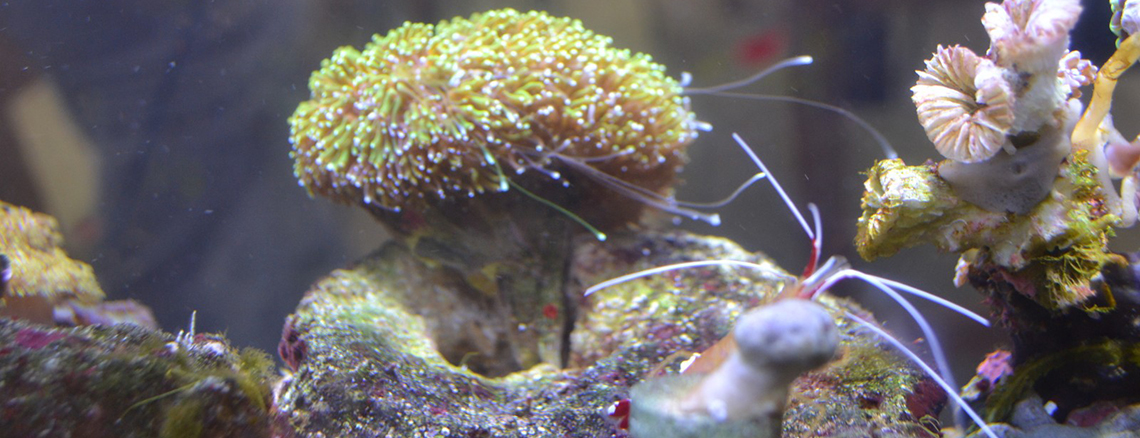
Coral Propagation at UMM Huge Success
In the cool, daylight basement of the Science Building on the University of Maine at Machias campus, a dozen research aquariums are bubbling away, tended carefully by senior student Clair Aldrich and Biology Professor Dr. Gayle Kraus.
The salt-water tanks are filled with colorful fish, rippling eels, and shrimp the size of your hand that look like vibrant red spiders, but the stars of the underwater show are the corals. Undulating and glowing in the artificial current, sending out tentacles when neighbors get too close, these small but stunning specimens are part of Aldrich’s UMM’s Coastal University research.
Her coral farms, enfolded into Kraus’s Ichthyology Class, has two goals: to help save endangered coral reefs by providing locally grown specimens for other researchers and hobbyists, and to study algae that can help combat reef bleaching.
[pullquote align=”center”]
“Clair’s work is a great example of the kind of hands-on undergraduate research and applied learning that characterizes our UMM programs,” UMM President Sue Huseman said. “Students leave us with both in-depth knowledge of their fields and experience applying that knowledge in the wider world.”
[/pullquote]
Reefs make up less than one percent of Earth’s undersea ecosystems, but don’t underestimate their importance. They shelter 25 percent of marine species, protect shorelines, support fishing industries, provide tourist dollars, and could be home to the next big, undiscovered medical breakthrough. But climate change, fishing practices, and souvenir harvesting are taking their toll. “Coral is one of the most sensitive organisms on the planet,” said Kraus. “They live in such a narrow range of light and acidity.”
As the oceans rise in temperature and tropical storms become more severe, vital algae and the corals they feed are destroyed. Warmer water temperatures can result in coral bleaching. When water is too warm, corals will expel the algae (zooxanthellae) living in their tissues causing the coral to turn completely white.
“Some of the algae help the corals become more resistant to bleaching,” explained Aldrich. Lab experiments to determine exactly which algae are beneficial could help restore and replenish reefs.

This undertaking is research on the cheap. While funding for state universities continues to decline, they are still prime locations for major research and Kraus explains that at UMM “We are doing it low tech, much more affordable.” Because Aldrich is growing her corals under LED lighting, the energy costs are dramatically lower than metal halide lighting, which is the norm. Each 55-gallon aquarium setup costs about $600 and uses 75 percent less energy. The chance of fires and burns from the much hotter metal halide lighting is also eliminated.
In addition, Aldrich has developed an additional cost-saving system to recharge the sea salt in the tanks so that only about three gallons of water in each tank needs to be replaced weekly.
Aldrich became interested in corals while still in high school in Freeland, Michigan. Her senior project tested the effects of biodegradable sunscreens on corals. (There wasn’t much of an effect.) At UMM, Aldrich has written a manual on growing and propagating corals for future marine biology students.
Beyond the research implications of Aldrich’s project, Kraus said, the work is key to UMM’s marine biology program. “Students here get the experience of seeing the corals alive and watch their behaviors, as well as learning the scientific documentation process. Many of our students will not have an opportunity to see a reef for themselves.
“All of us in the marine field are upset by the aquarium trade that takes so much from the wild. But here, we raise and propagate and then we’ll resell,” she said. “UMM students are part of a much bigger effort to protect the reefs. Clair’s genetics work with the coral is definitely a really important effort.”
